Click image for BBB rating
See our Privacy Policy
cool="cool" width="786" height="9105" border="0" cellpadding="0" cellspacing="0" gridx="16" showgridx="showgridx" usegridx="usegridx" gridy="16" showgridy="showgridy" usegridy="usegridy" bgcolor="#99ccff">
|
|
|
|
|
|
|
|
|
 |
|
Spaightwood Galleries
|
|
|
|
|
|
|
|
This 2001 show considered the paradoxical role of five Spanish artists—all of whom spent large portions of their lives fleeing authoritarian governments or a culture that seemed to require that they leave in order to find themselves—in defining many of the chief artistic movements of the last century. We included over 130 original prints by Picasso, Miró, and Tàpies, sculptures, drawings, and prints by Artigas, and paintings on canvas, board, and paper, monotypes, and prints by Llèdos. All of these artists are familiar to followers of Spaightwood. Among the works featured in the show were one of Picasso's earliest prints (from 1905) plus later works scattered throughout his career, two wonderful new etchings acquired from the widow of one of Miró's printers plus others added since our last Miro show, and never before shown works by Tapies, Artigas, and Lledos (not to mention many masterpieces we have shown before that may be new, as Prospero tells Miranda at the end of The Tempest, to thee).
The show included over 130 works, many of which have been shown in museums all over the world, so even if you have seen them before, you may enjoy seeing them again. C. S. Lewis once said that a book that's only worth reading once isn't worth reading at all; we find the same to be true of art as well: if a work of art cannot grow richer and inspire more complex responses the more it is seen, it's perhaps best thought of as a cheap thrill no matter how expensive it is (and some of the thrills in this show did not fit most people's definition of cheap though thankfully many did: prices of prints by Artigas and Lledos are still quite affordable; prices for Picasso, Miro, and Tapies prints are still within the realm of possibility—especially for unsigned works— though their paintings have all sold for prices in the millions (and even tens of millions in the cases of Picasso and Miro).
Picasso, Miro, and Tapies have each created works that have defined the limits of the possible for other artists; Artigas and Lledos are still working within the heritage bequeathed them by their countrymen, but both have created large and growing bodies of works that are instantly recognizable as their own and both are getting more and more assured of their own visions as they have built up over the past few decades bodies of work that have allowed them to build newer and richer works upon the foundation of what they have already achieved. As Miro had to digest what Picasso had done before he could receive Picasso's ultimate accolade that only he had taken painting past the place where Picasso had left it, and as Tapies had to be freed from Franco's attempts to repress modernism by his understanding of what Picasso and, especially, Miro had achieved, so Artigas, who collaborated with Miro for over twenty years on ceramic sculptures and murals (he also taught Chagall, Braque, Chillida, and Tapies how to work in ceramics) and Lledos, who had to absorb how Tapies used abstraction as a weapon against the culture that Franco was trying to impose upon Spain (much as Hitler and Stalin had made purging all of the artists who refused to give up the freedom to build their own visions upon the achievements of those who came before them and who refused to throw them over for the then "cutting-edge" styles of Socialist Realism and Nazi-approved non-"decadent" "patriotic" art) before he could freely work in a foreign culture to build a bridge from his past to a very new present.
In America, art galleries and often museums tend to focus on the new and neglect the old; this may explain why we have such a fragmented visual culture that few artists find it possible to produce an evolving body of work over a lifetime. In Europe, however, where thousands of years of art offer themselves to the eye in almost any city (sometimes, even any church or public building), one could only ignore the past by blinding oneself (perhaps this is what Oedipus really had in mind).
|
|
|
|
|
|
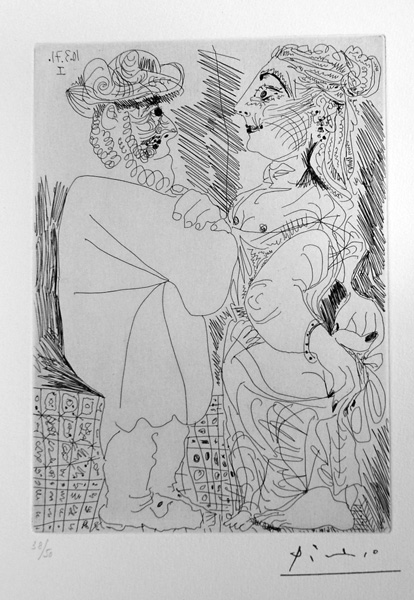 |
|
Series 156: 70. Artist and Model (Bloch 1927, Baer 1936). Original etching, 1971. 50 numbered impressions signed with the estate signature stamp. Executed 3/10/71 and approved by Picasso before his death, this etching, like the others in this series, was printed posthumously. An artist watches a beautiful young model with her arms attached backwards. Most of the etchings in the 156 Series show artists (including Rembrandt, Degas, and Picasso himself). often aged, looking at their beautiful young models. Here the artist, who appears to be wearing 17th-century buckles on his boots, seems to be focused on the woman's eyes to the exclusion of all other aspects of her which are amply, if oddly, revealed. Image size: 210x150mm. Price: Please call or email for current pricing information.
|
|
|
|
|
|
|
|
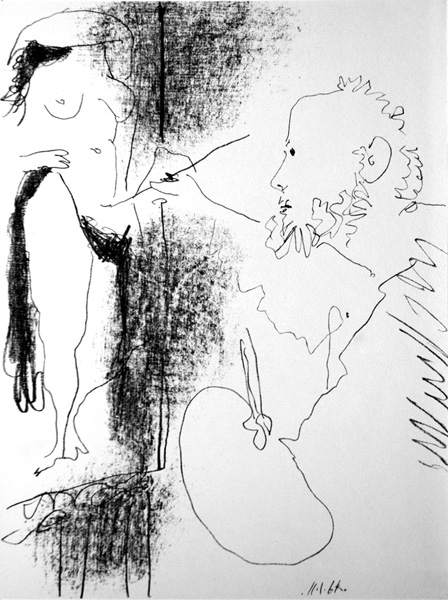 |
|
The Painter and his Model (Mourlot 399, Bloch 1155). Original lithograph, 1964. 3000 unsigned impressions for Picasso Lithographe IV. This lithograph served as the frontispiece to the book. It is one of a long series of lithographs and etchings Picasso has made on this theme, which was particularly important to him from 1963-65. Image size: 320x235mm. Price: Please call or email for current pricing information. These two lithographs were executed on the same day.
|
|
|
|
|
|
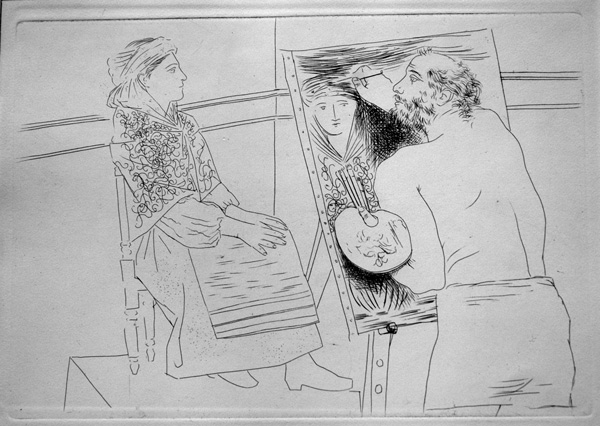 |
|
|
Peintre chauve devant son Chevalet / Bald painter at this easel (B. 87; G. 128/b). Original etching, 1927. 65 signed impressions on Japan plus 340 unsigned impressions (of which 240 are printed on Rives as ours). This etching, commissioned and published by Ambroise Vollard and printed by Louis Fort, was published in 1931 for his deluxe artist's book of Balzac's Le Chef-d'Oeuvre inconnu / The unknown artist's masterpiece. Each pencil-signed portfolio contained 13 unsigned etchings and 67 wood-engravings by Georges Aubert after Picasso's drawings. Illustrated in Picasso: 60 Years of Graphic Works (LA County Museum of Art, 1967, p. 37) and Magdalena M. Moeller, Picasso Druckgraphik . . . aus dem Sprengel Museum Hannover (Propylaen, 1986, p. 82). Image size: 194x278mm. Price: Please call or email for current pricing information.
|
|
|
|
|
|
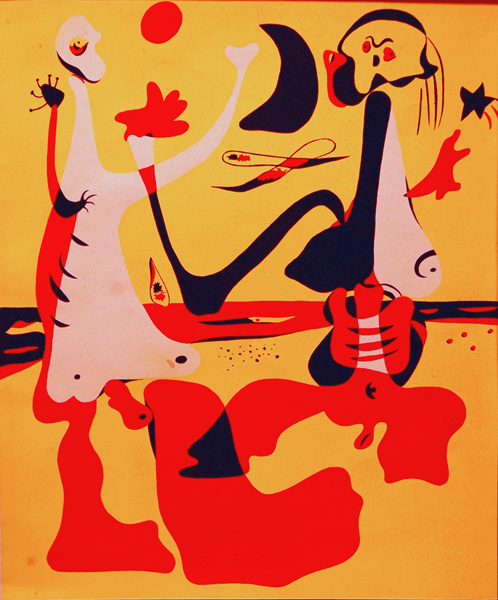 |
|
Personnages devant la mer / Figures by the sea shore (Dupin 13). Original color pochoir, 1934. Published in December 1934 in the art journal D'Aci i D'Alla; printed by J. Mateu, Pochoir Publicity Art, barcelona, 1934. The number impressions of this prochoir is unknown, as is the number that might have been destroyed during the Spanish Civil War soon to follow, What we do know is that impressions of this piee are rarely aavailable in the art market (this is only the second impression of this that we have seen since 1975). This is one of Miró's most surreal prints showing a male and a female figure reaching out for each other in lust or terror while the leg of the female figure on the right seems to interpenetrate the leg of the male figure on the left. A rare and beautiful print with the surface texture of a gouache slightly marred by two small flaws in the shape of spots in the lower left corner by the heel of the male figure and on the right side of the white torso of the male figure. The spot on the torso is not red but gray; the spot by the heel is a discoloration slightly darker than the yellow where it occurs. Image size: 315x245mm. Price: Please call or email for current pricing information.
|
|
|
|
|
|
|
|
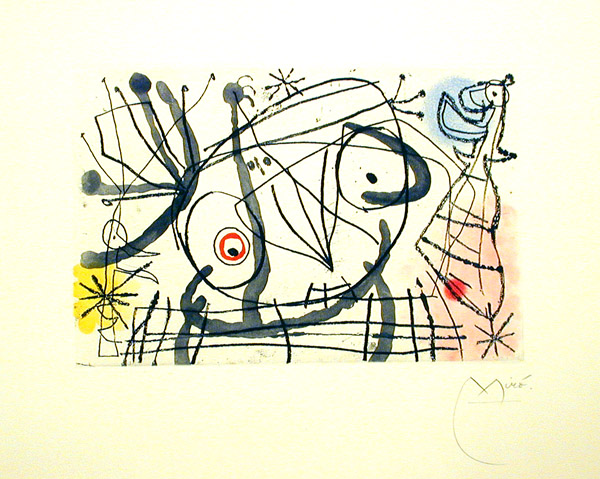 |
|
|
Fissures IIa (Dupin 466, Cramer 130). Original color soft varnish-etching and aquatint, 1969. Edition: 75 signed & numbered impressions plus 20 HC impressions. Ours is a printer's proof on BFK Rives. Published by Maeght, Paris; our impression comes from the widow of the printer, Robert Dutrou, one of Miró's favorite collaborators. Image size: 195x290mm. Price: Please call or email for current pricing information.
|
|
|
|
|
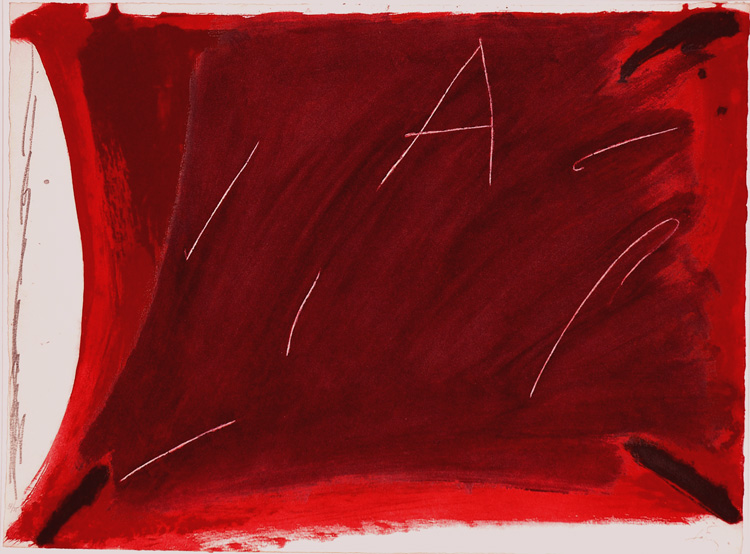 |
|
|
Negre i roig V: A damunt vermell (Galfetti 613). Original color etching with flocking and aquatint, 1976. 75 signed and numbered impressions on Guarro paper published by Ediciones Poligrafa in Barcelona, of which ours is n. 53/75. This is a an inadquate represnetation of the wonderfulness of this piece: the central area is a much redder darkness (almost maroon) than here appears. In real life, this is, in fact, one of Tàpies most beautiful prints. Image size: 560x760mm. Price: Please call or email for current pricing information.
|
|
|
|
|
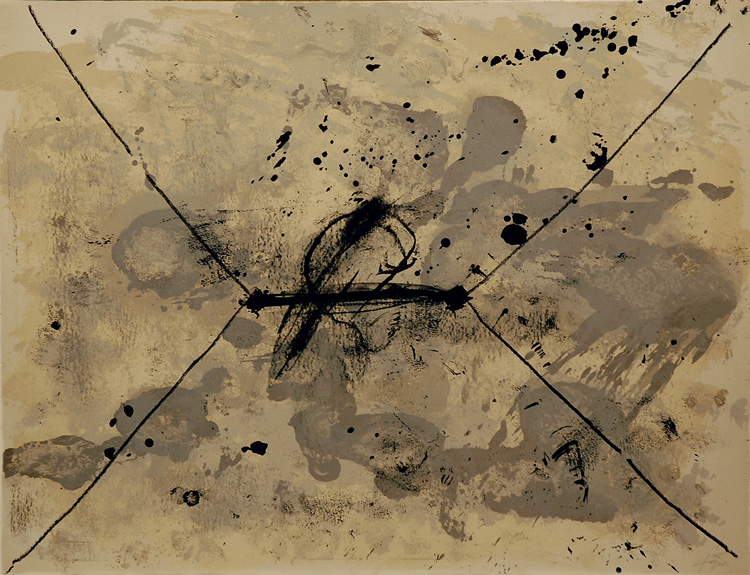 |
|
|
|
L'Enveloppe (Galfetti 155). Original color lithograph, 1968. 75 signed and numbered impressions printed by Imprimerie Adrien Maeght and published by Galerie Maeght, Paris. Our impression is annotated HC lower left. A very good, bright impression in very good condition. This work is discussed at some lenght in Riva Castleman, Contemporary Prints (NY: Viking, 1973). For Castleman, Curator of Prints and Illustrated Books emeritus at the Museum of Modern Art, this print embodies the essence of Tàpies's prints: "Graffiti or the calligraphic element has taken on an increasingly important role in Tàpies' work in recent years, and particularly in his prints. These remnants of the human compulsion to graphic expression are rarely transcribed by Tàpies as recognizable words. . . . the envelope shapeis indicated by line and the seal is a nervous scribble" (p. 72). Like many of the "vestiges of human presence" in his works, the envelope offers us an attempt at communication that that cannot communicate much more than our desire to do so at the same time it consoles us with the occasional beauty that can come from the failure of our attempts to do so. One of Tàpies' masterprints. Image size: 515x675mm. Price: Please call or email for current pricing information.
|
|
|
|
|
|
|
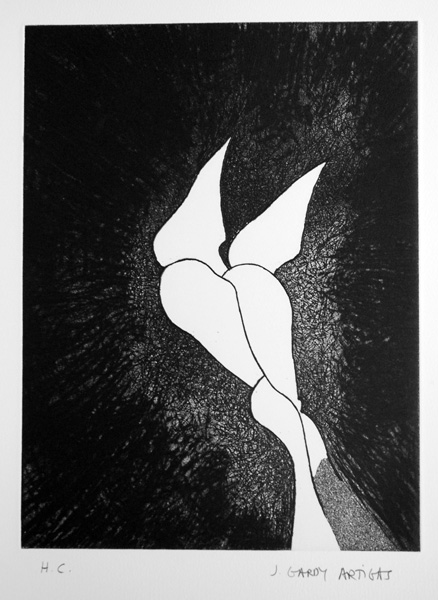 |
|
L'ange de la morte / The angel of death. Original etching, 1975. 75 signed and numbered impressions on Arches published by Maeght Editeur in Paris. Ours is an HC impression acquired directly from the artist. Artigas has explained his love of etchings as follows: "If I want a secret image with a magic quality, I turn to etching. The pressure of the damp paper will insure that the intensity of the black, the relief of the features etched on the copper will remain on the paper, giving it a richness and a finesse that forces us to look closely at it, making us wish to hold the etching in our hands, to feel the quality of the paper. The result is a work more secret, more intimate—more precious." Image size: 393x297mm on 695x500mm Arches paper. Price: Please call or email for current pricing information.
|
|
|
|
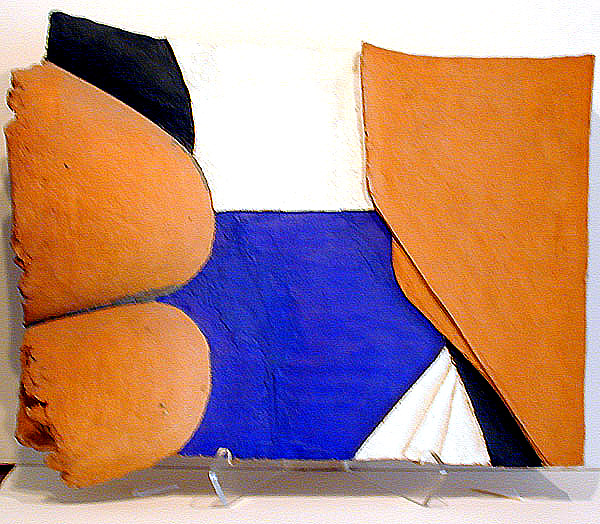 |
|
|
Mediterranean dream. Ceramic sculpture with acrylic paint, 1983. Executed while Artigas was a visiting artist at the University of Wisconsin–Madison. Size: 486x560x90mm. Please call or email for current pricing information.
|
|
|
|
|
|
|
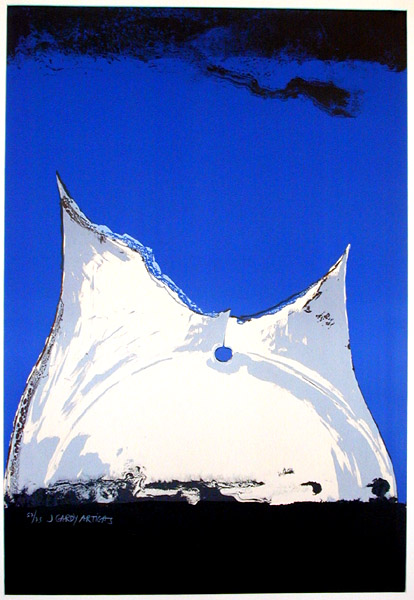 |
|
Platre / Plaster. Original color lithograph, 1968. 75 signed and numbered impressions published by Maeght Editeur in Paris. This work is related to a series of fragmentary plaster sculptures Artigas was making at the time. One of Artigas' earliest lithographs, the image offers a glimpse at the mysterious process involved in the creaion of ceramic scultures as the wood-fired kiln turns the soft and maleable clay into the stone-like yet vulnerable surface of the ceramic sculpture. Artigas has explained his love of lithography as follows: "If I want power, impact, a startling image, I use lithography. With the technique of printing directly off the stone, it is possible to get a maximum of ink on the paper. This ... allows ... powerful color." Image size: 865x595mm. Price: Please call or email for current pricing information.
|
|
|
|
|
|
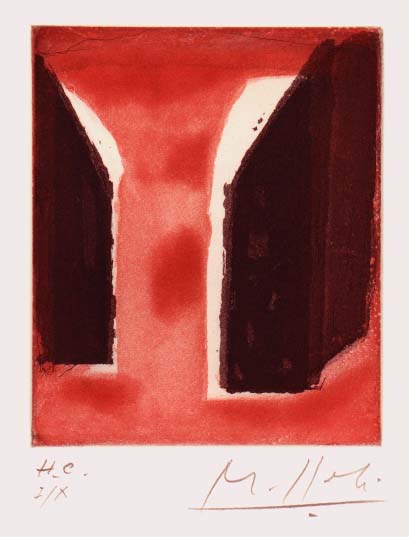 |
|
|
|
Graven Images. Original etching and aquatint, 1996. 100 signed and numbered impressions plus x hc impressions for Madness, Melancholy, and the Limits of the Self: Studies in Culture, Law, and the Sacred. Volume III in the Graven Images Monograph Series published by the University of Wisconsin Law School and distributed by the University of Wiscinson Press. Llèdos was born in Barcelona and lives in New York City. His work has been shown at the Chicago and LA International Art Fairs, and he has been featured in both one-person shows & group shows in the US, Canada, Spain, and South America. In 1984 he was awarded the Prize of the Americas. He is currently an Associate Professor of Art at one of the campuses of the City University of New York.Image size: 143x118mm. Price: Please call or email for current pricing information.
|
|
|
|
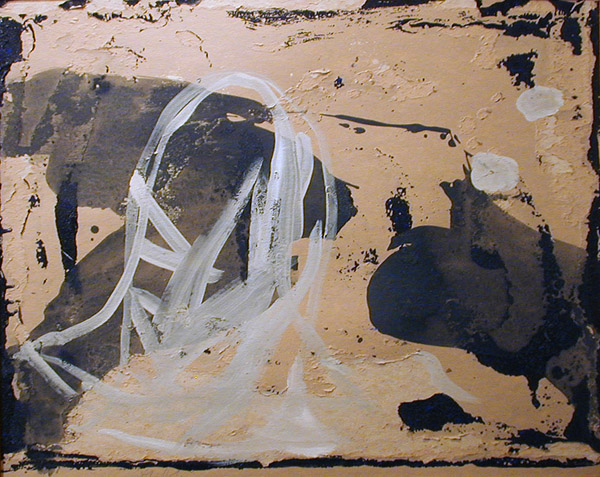 |
|
|
|
Beast. Acrylic on cardboard, 1989. Lledos was born in Barcelona and lives in New York City. His work has been shown at the Chicago and LA International Art Fairs, and he has been featured in both one-person shows & group shows in the US, Canada, Spain, and South America. In 1984 he was awarded the Prize of the Americas. He is currently an Associate Professor of Art at one of the campuses of the City University of New York. Image size: 813x1016mm. Price: Please call or email for current pricing information.
|
|
|
|
|
|
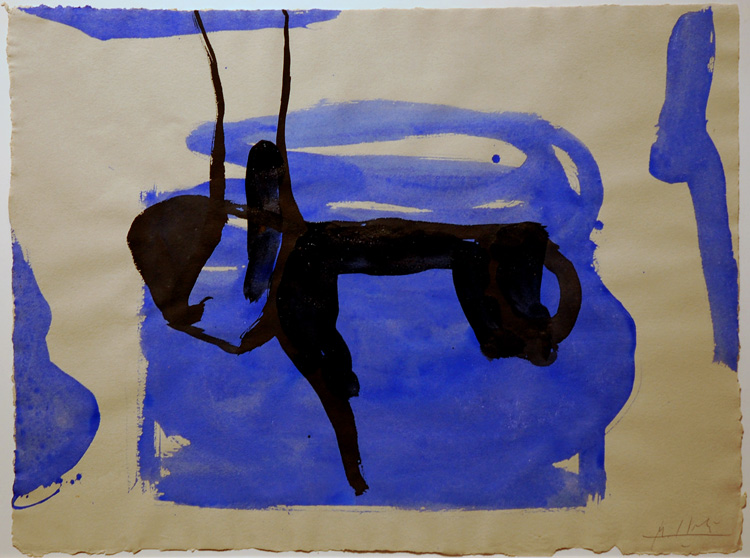 |
|
|
|
Bird and Sky. Original acrylic and ink on handmade gray paper, 1989. Signed in pencil lower right. Image size: 550x730mm. Price: Please call or email for current pricing information.
|
|
|
|
|
|
Spaightwood Galleries, Inc.
To purchase, call us at 1-800-809-3343 (1-508-529-2511 in Upton MA & vicinity) or send an email to spaightwood@gmail.com. We accept AmericanExpress, DiscoverCard, MasterCard, and Visa.
For directions and visiting information, please call. We are, of course, always available over the web and by telephone (see above for contact information). Click the following for links to past shows and artists. For a visual tour of the gallery, please click here. For information about Andy Weiner and Sonja Hansard-Weiner, please click here. For a list of special offers currently available, see Specials.
Visiting hours: Saturday 10:00 am to 5:00 pm and Sunday noon to 6:00 pm and other times by arrangement. Please call to confirm your visit. Browsers and guests are welcome.
|
|
|
|
|
|
|
|
|
|
|
|
|
|
|
|
|
|
|
|
|
|
|
|
|
|
|
|
|
|
|
|
|
|
|
|
|
|
|
|
|
|
|
|
|
|
|
|
|
|












